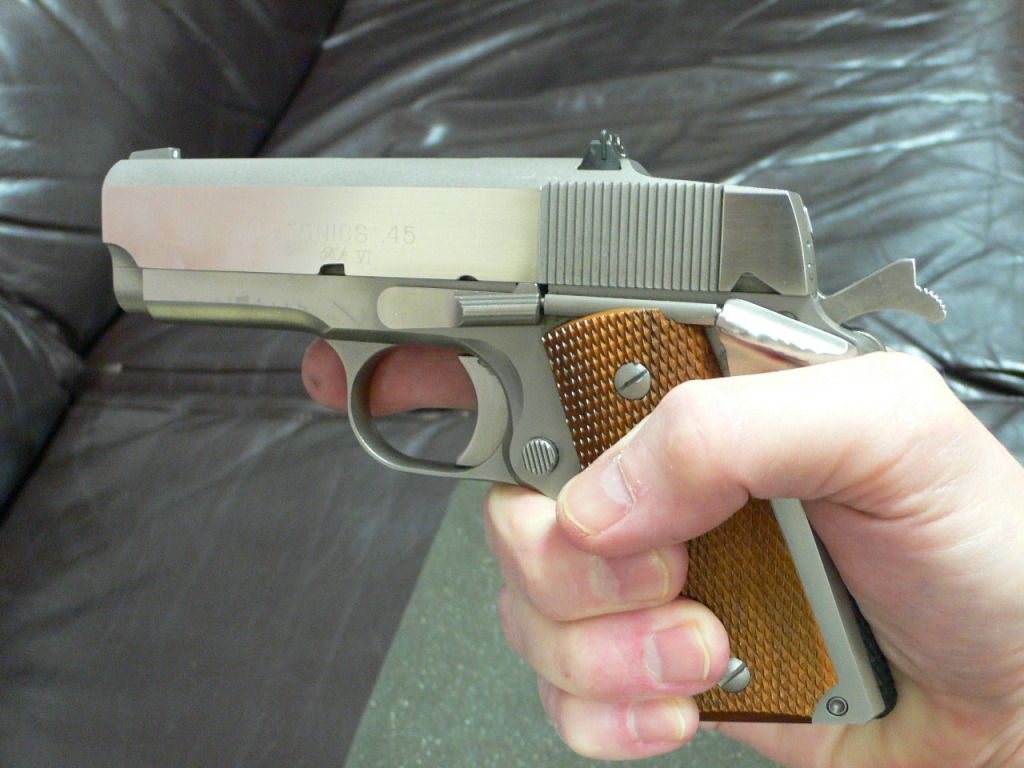 |
| Photo's in this article are by the original author. |
www.watchtryst.com/showthread.php?t=1969
"The Detonics .45 - praise for a legend
As promised, a short treatise on the legendary Detonics .45 ACP pistol, which was and remains my all time favorite .45 auto.
I don't need to get into the efficacy of the .45 ACP round for this. For years after WWII, countless folks were trying to come up with a way to make the basic 1911 Colt-pattern pistol into a smaller package for easier concealment, with varying degrees of (un)success. The problem, mostly, was how to tame the recoil, especially in a pistol that by necessity would have a shorter slide, and thus a shorter travel when cycling. The usual approach was to use a much stiffer spring with buffer pads at the rear end. The downside to this was that although this could help relieve a good deal of the felt recoil to the hand, it made it nearly impossible to use different types of rounds as the cup pressure of the round had to be more or less mated to the particular spring used. It also did nothing to reduce muzzle flip, another big concern.
Long about the early '70's a couple of guys came up with a radical idea for springing a chopped .45. Instead of a single spring captured at the front end by a spring plug mated to a barrel-bushing, use a self-contained multiple spring unit, with the springs counterwound to cancel out the wave-pulse generated when the individual spring is compressed. Make the springs/guide rod/front plug into one self contained unit which never needed disassembly, and while we're at it, get rid of the barrel-bushing (a nuisance part if ever there was one), in favor of a self centering barrel. Keep the rest of the Browning operating system the same; after all, it was nothing if not reliable.
The concept for the Detonics pistol was born. Starting around 1976, armed with patents for their counterwound recoil spring system and tapering-cone self-centering bull barrel, Detonics began producing pistols. The first pistols used standard, chopped 1911 frames/slides, standard trigger/sear assemblies, and the same Browning drop-link operating system. To these were added the Detonics stainless steel tapering cone bull barrel, the recoil spring and guide rod assembly and some cool customization: beveled ejector port, beveled magazine well, bobbed hammer, throated and polished feed ramp, and a pinned grip safety (owing to the shortness of the grip). All of this came standard on the new Detonics .45, which was dubbed the Combat Master. It was ready to go right out of the box.
Meaning, of course, that after a mere 100-round break-in period, the owner was good to begin carrying the pistol with about as much assurance of reliabilty as was possible.
The pistol was an instant hit with law enforcement, for two reasons: obviously, the size was an advantage, but mostly because the gun functioned equally well with any type of ammo, and the felt recoil and muzzle flip was actually less than a full-sized 1911.
Later on the company began producing all-stainless versions, using frames and slides fabricated in-house. This, at the time was no mean feat. Stainless steel slides and frames had notoriously suffered from failure due to galling of the rails. Detonics solved this by using two different grades of stainless steel.
For those who keep track of these things, Sonny Crockett on Miami Vice carried a Detonics .45 in an ankle holster, and it made a few appearances on the show.
Below is an example of a Detonics .45 from 1986. This one was their highest-end variant, with polished slide sides and windage-adjustable rear sight. Two 6-rd stainless magas were standard.
^
Note the position of the rear sight, about 1.5" forward of the traditional position. This was done to allow easier cocking of the shorter hammer (notice it is about the length of the distal phlanx of the human thumb) and to reduce sight acqusition time. Remember, the pistol was meant for use in 7-yd self-defensive combat situations, and for ease of concealment and draw without catching on clothing. Naturally, traditionalist .45 aficionados cried foul, unitl they started printing 2" groups rapid-fire from the draw at 7 yards, noting both the ease of sight acquisition and the reduction of muzzle-flip, coupled with the inherent accuracy of the self-centering tapered cone barrel.
^
Field-stripping the Detonics worked just like the standard 1911, only a whole lot simpler: 4 parts, including the slide-stop pin.
^
Pictured above, the heart of the beast. The tapering-cone self-centering bull barrel, and the spring assembly, featuring three counterwound springs on the guide rod. Buffer pads were totally unnecessary.
^
Beveled mag wells and ejection ports were standard on all Detonics .45 pistols.
^
For those of us who are somewhat size-impaired, here is a full-power .45 auto, with a 3.5" barrel, just slightly larger than a Walther PPK/s
^
Needless to say, anyone unfortunate enough to behold the business end of this baby was suitably "impressed".
Later on in this thread, I'll get into the rest of the Detonics story, and how their innovations are still with us today.
doc - out !! "
I don't need to get into the efficacy of the .45 ACP round for this. For years after WWII, countless folks were trying to come up with a way to make the basic 1911 Colt-pattern pistol into a smaller package for easier concealment, with varying degrees of (un)success. The problem, mostly, was how to tame the recoil, especially in a pistol that by necessity would have a shorter slide, and thus a shorter travel when cycling. The usual approach was to use a much stiffer spring with buffer pads at the rear end. The downside to this was that although this could help relieve a good deal of the felt recoil to the hand, it made it nearly impossible to use different types of rounds as the cup pressure of the round had to be more or less mated to the particular spring used. It also did nothing to reduce muzzle flip, another big concern.
Long about the early '70's a couple of guys came up with a radical idea for springing a chopped .45. Instead of a single spring captured at the front end by a spring plug mated to a barrel-bushing, use a self-contained multiple spring unit, with the springs counterwound to cancel out the wave-pulse generated when the individual spring is compressed. Make the springs/guide rod/front plug into one self contained unit which never needed disassembly, and while we're at it, get rid of the barrel-bushing (a nuisance part if ever there was one), in favor of a self centering barrel. Keep the rest of the Browning operating system the same; after all, it was nothing if not reliable.
The concept for the Detonics pistol was born. Starting around 1976, armed with patents for their counterwound recoil spring system and tapering-cone self-centering bull barrel, Detonics began producing pistols. The first pistols used standard, chopped 1911 frames/slides, standard trigger/sear assemblies, and the same Browning drop-link operating system. To these were added the Detonics stainless steel tapering cone bull barrel, the recoil spring and guide rod assembly and some cool customization: beveled ejector port, beveled magazine well, bobbed hammer, throated and polished feed ramp, and a pinned grip safety (owing to the shortness of the grip). All of this came standard on the new Detonics .45, which was dubbed the Combat Master. It was ready to go right out of the box.
Meaning, of course, that after a mere 100-round break-in period, the owner was good to begin carrying the pistol with about as much assurance of reliabilty as was possible.
The pistol was an instant hit with law enforcement, for two reasons: obviously, the size was an advantage, but mostly because the gun functioned equally well with any type of ammo, and the felt recoil and muzzle flip was actually less than a full-sized 1911.
Later on the company began producing all-stainless versions, using frames and slides fabricated in-house. This, at the time was no mean feat. Stainless steel slides and frames had notoriously suffered from failure due to galling of the rails. Detonics solved this by using two different grades of stainless steel.
For those who keep track of these things, Sonny Crockett on Miami Vice carried a Detonics .45 in an ankle holster, and it made a few appearances on the show.
Below is an example of a Detonics .45 from 1986. This one was their highest-end variant, with polished slide sides and windage-adjustable rear sight. Two 6-rd stainless magas were standard.
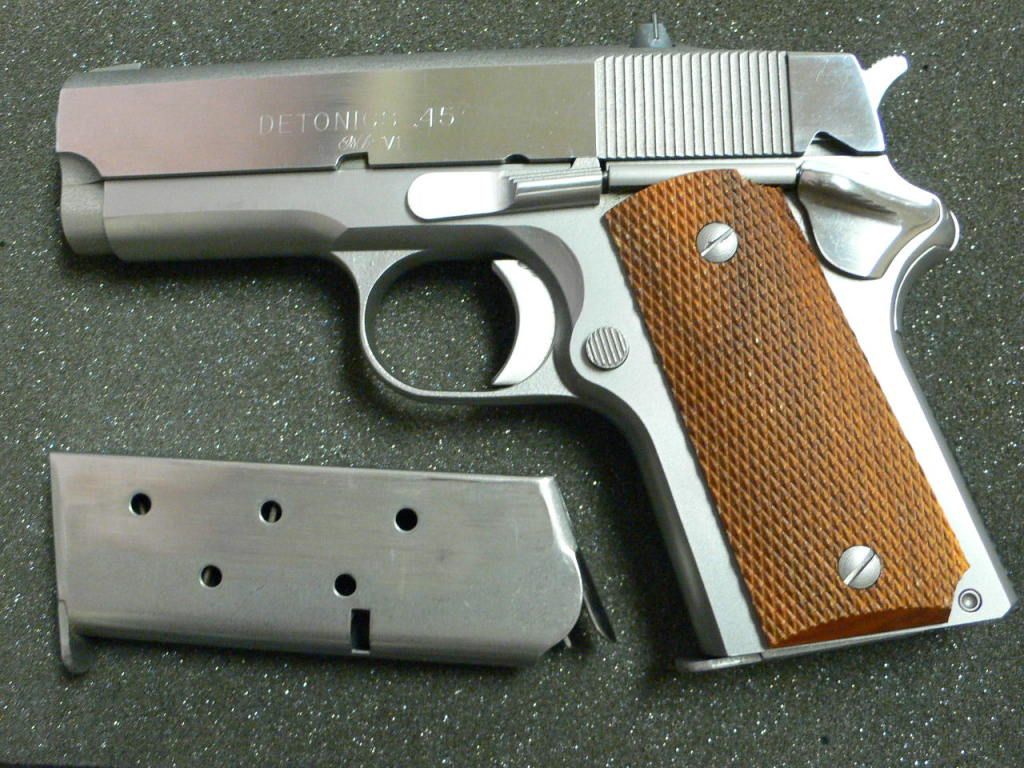 |
| Photo by author |
Note the position of the rear sight, about 1.5" forward of the traditional position. This was done to allow easier cocking of the shorter hammer (notice it is about the length of the distal phlanx of the human thumb) and to reduce sight acqusition time. Remember, the pistol was meant for use in 7-yd self-defensive combat situations, and for ease of concealment and draw without catching on clothing. Naturally, traditionalist .45 aficionados cried foul, unitl they started printing 2" groups rapid-fire from the draw at 7 yards, noting both the ease of sight acquisition and the reduction of muzzle-flip, coupled with the inherent accuracy of the self-centering tapered cone barrel.
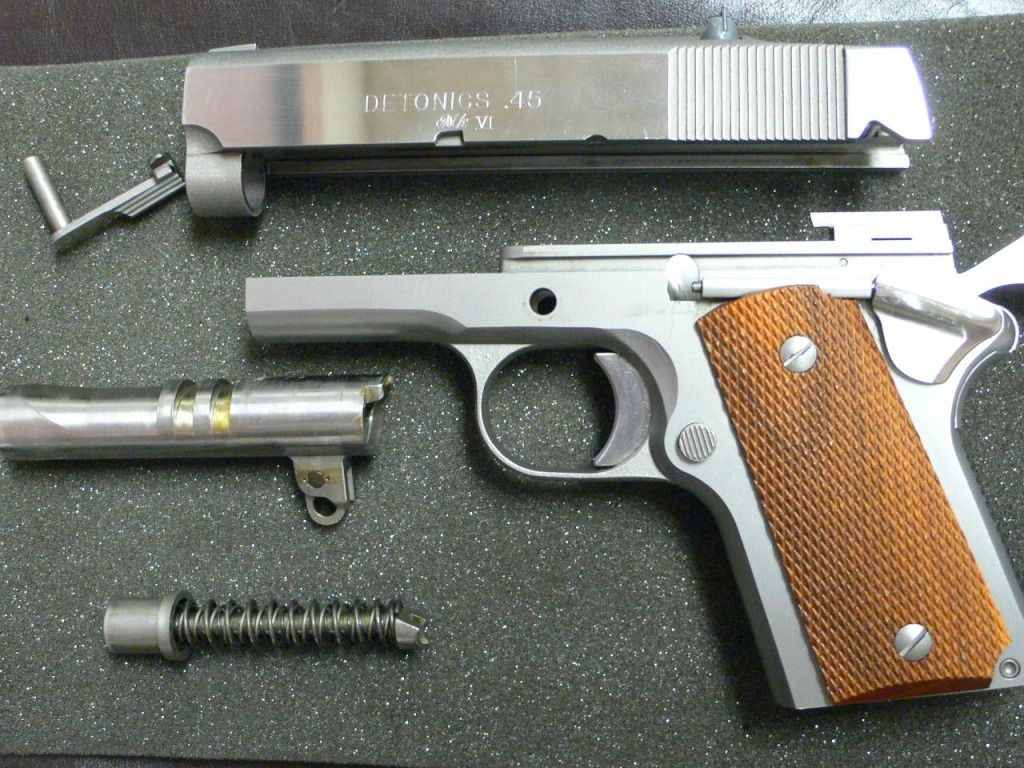 |
| Photo by author |
Field-stripping the Detonics worked just like the standard 1911, only a whole lot simpler: 4 parts, including the slide-stop pin.
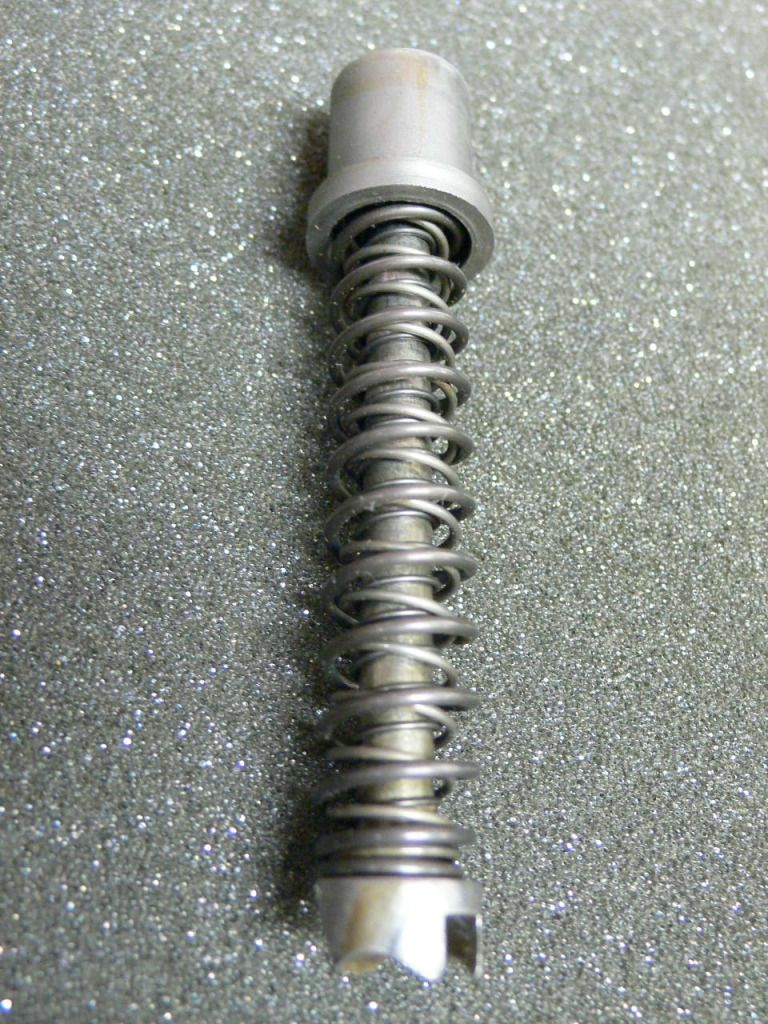 |
| Photo by author |
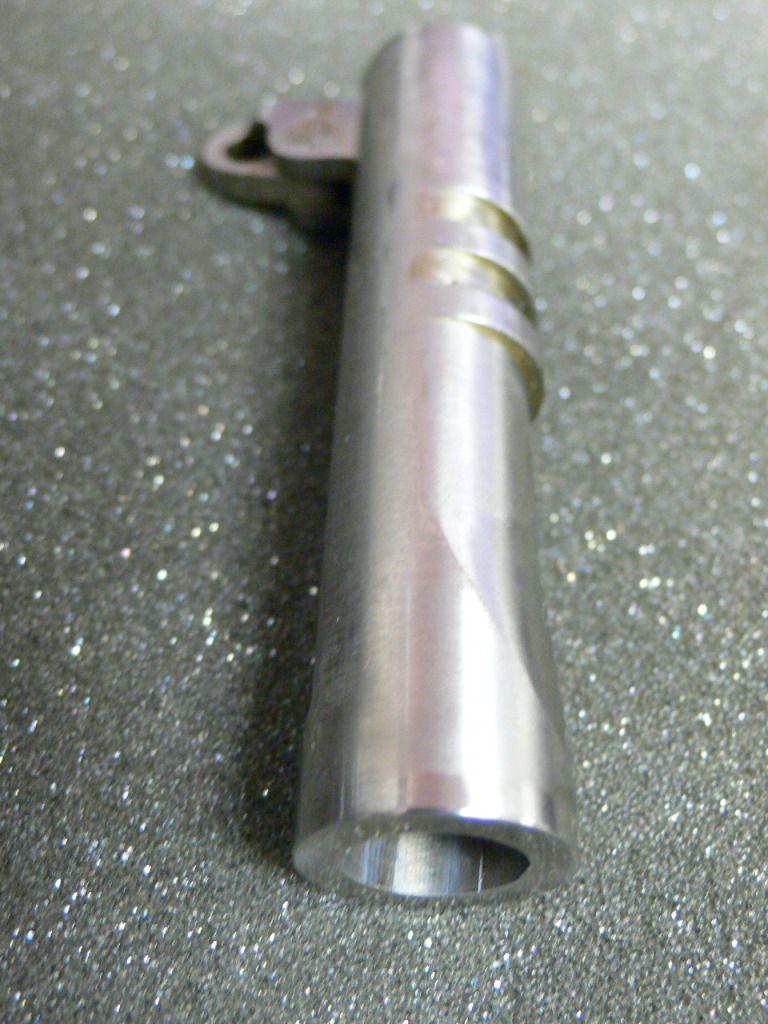 |
| Photo by author |
Pictured above, the heart of the beast. The tapering-cone self-centering bull barrel, and the spring assembly, featuring three counterwound springs on the guide rod. Buffer pads were totally unnecessary.
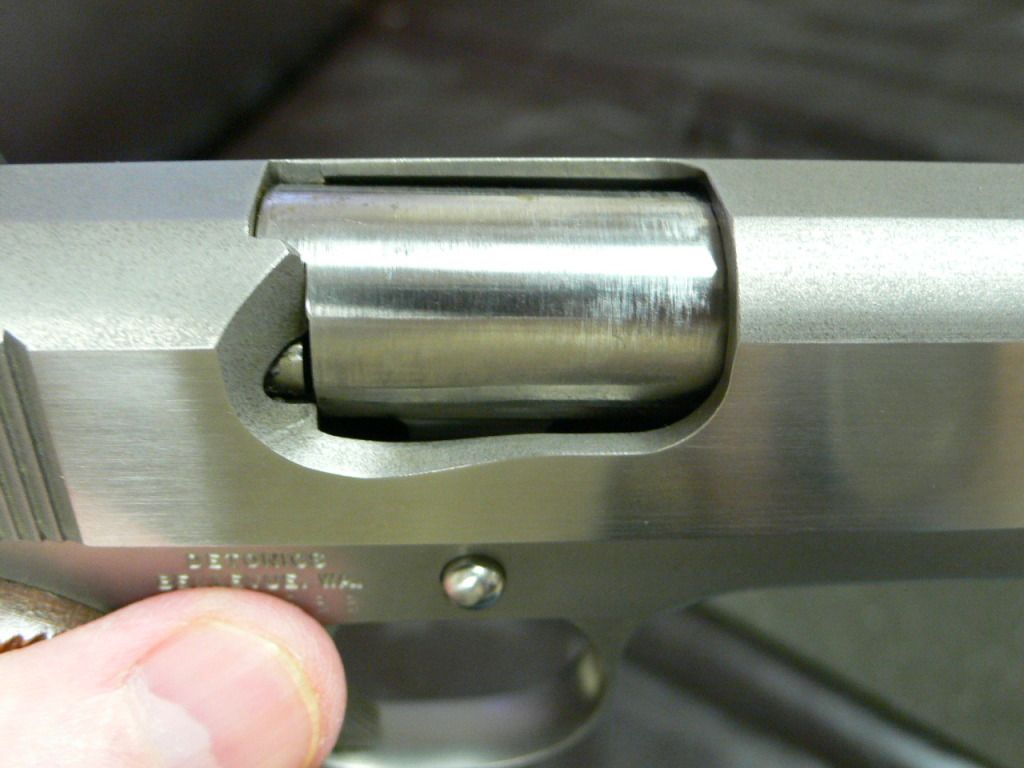 |
| Photo by author |
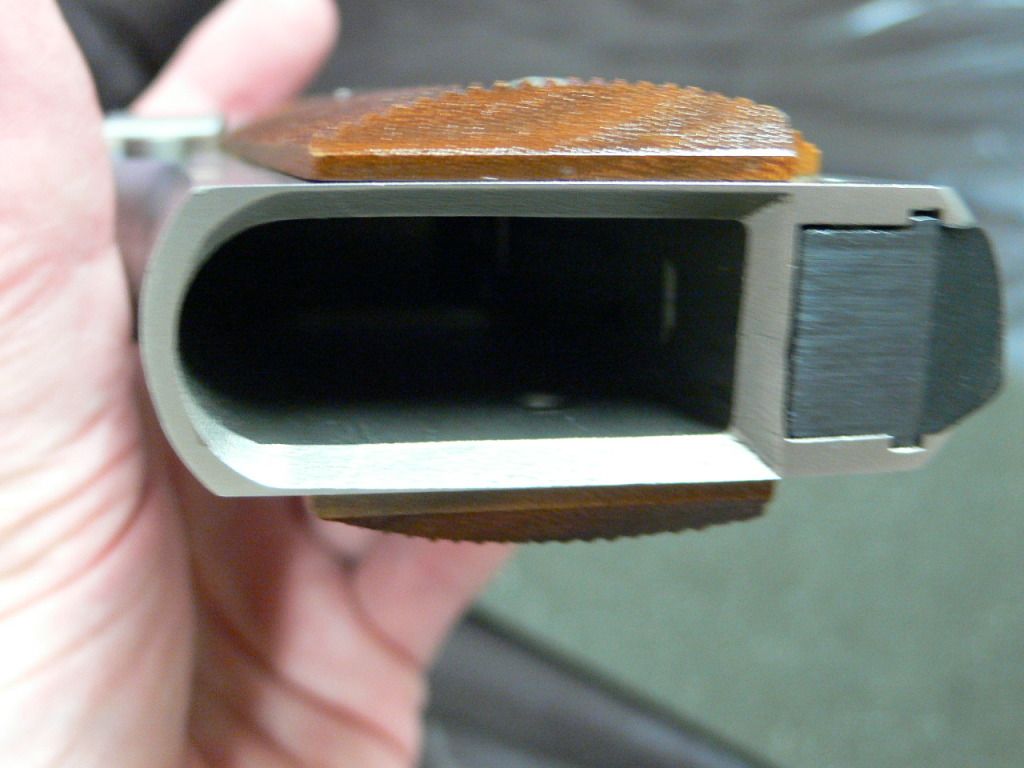 |
| Photo by author |
Beveled mag wells and ejection ports were standard on all Detonics .45 pistols.
 |
| Photo by author |
For those of us who are somewhat size-impaired, here is a full-power .45 auto, with a 3.5" barrel, just slightly larger than a Walther PPK/s
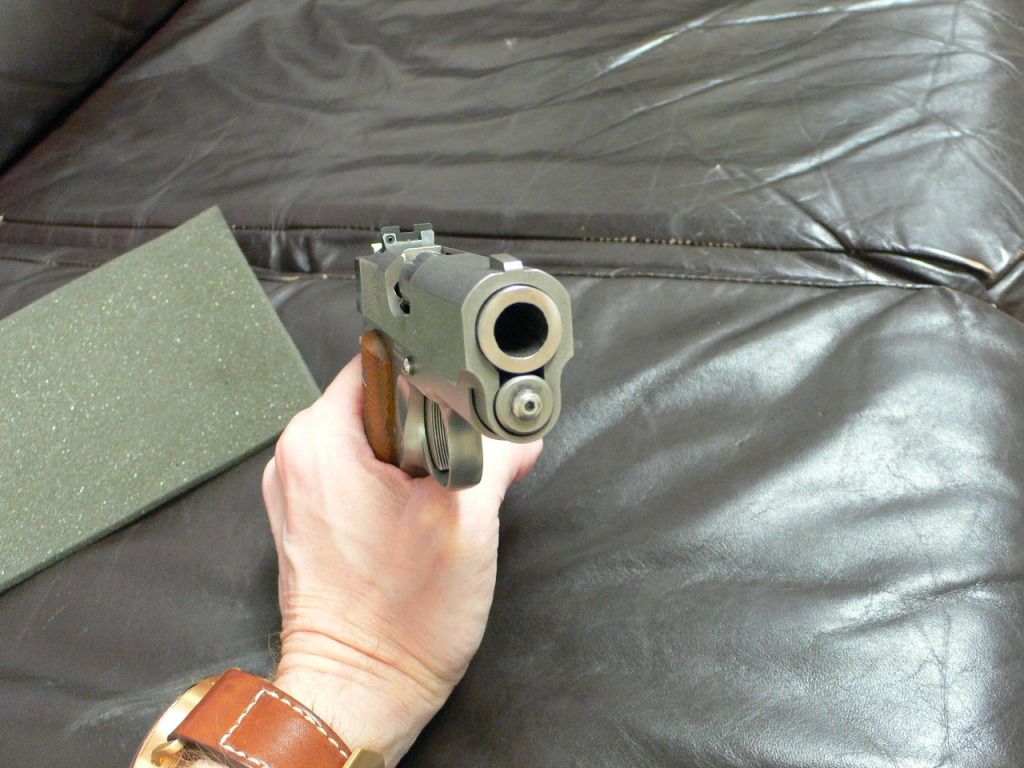 |
| Photo by author |
Needless to say, anyone unfortunate enough to behold the business end of this baby was suitably "impressed".
Later on in this thread, I'll get into the rest of the Detonics story, and how their innovations are still with us today.
doc - out !! "
Casino Roll - Casino Roll
ReplyDeleteWelcome to our website. You can 토토 사이트 운영 find a new page from casino 메이저벳 roll here. 하하 포커 You can enjoy more of the games, bonuses 승인 전화 없는 사이트 and promotions offered 바퀴벌레 포커 by casino